Halogen reactions Study guides, Class notes & Summaries
Looking for the best study guides, study notes and summaries about Halogen reactions? On this page you'll find 191 study documents about Halogen reactions.
Page 3 out of 191 results
Sort by
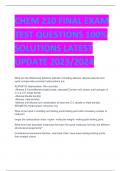
-
CHEM 210 FINAL EXAM TEST QUESTIONS 100% SOLUTIONS LATEST UPDATE 2023/2024
- Exam (elaborations) • 22 pages • 2023
-
- $12.09
- + learn more
CHEM 210 FINAL EXAM TEST QUESTIONS 100% SOLUTIONS LATEST UPDATE 2023/2024 What are the differences between aliphatic (including alkanes, alkenes,alkynes and cyclic compounds) aromatic hydrocarbons are. ALIPHATIC Hydrocarbon: Non-aromatic -Alkanes & CycloAlkanes:single bonds; saturated:Contain only carbon and hydrogen & C-C & C-H single bonds -Alkenes:double bond(s) -Alkynes: triple bond(s) *alkenes and alkynes are unsaturated: at least one C-C double or triple bond(s) AROMATIC H...
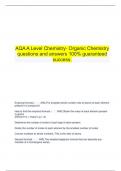
-
AQA A Level Chemistry- Organic Chemistry questions and answers 100% guaranteed success.
- Exam (elaborations) • 14 pages • 2024
-
- $13.49
- + learn more
AQA A Level Chemistry- Organic Chemistry questions and answers 100% guaranteed success. Empirical formula - ANS.The simplest whole number ratio of atoms of each element present in a compound How to find the empirical formula - ANS.Obtain the mass of each element present in grams (Element % = mass in g = m) Determine the number of moles of each type of atom present Divide the number of moles of each element by the smallest number of moles Co...
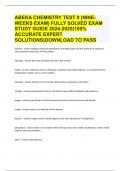
-
Abeka Chemistry Test 9 (Nine-weeks Exam) fully solved exam study guide 2024-2025(100% accurate expert solutions)download to pass
- Exam (elaborations) • 6 pages • 2024
- Available in package deal
-
- $16.49
- + learn more
chlorine halogen used in the disinfection of drinking water and the synthesis of medicines, crop-protection chemicals, and PVC plastics hydrogen the most abundant element in the universe Brainpower Read More Previous Play Next Rewind 10 seconds Move forward 10 seconds Unmute 0:00 / 0:15 Full screen helium noble gas used as a lifting gas in airships and weather balloons, as an extremely low-temperature coolant, and as a laser medium hydrogen isotopes are com...
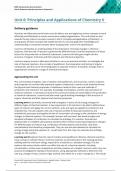
-
APPLIED SCIENCE UNIT 6: PRINCIPLES AND APPLICATIONS OF CHEMISTRY II
- Exam (elaborations) • 14 pages • 2024
-
- $10.99
- + learn more
Unit 6: Principles and Applications of Chemistry II Delivery guidance Scientists and laboratory technicians must be able to use and apply key science concepts to work efficiently and effectively in science and science-related organisations. This unit builds on and extends the key science concepts covered in Unit 2: Principles and Applications of Chemistry I. A strong grasp of these concepts will enable learners to use and apply their knowledge and understanding in vocational contexts...
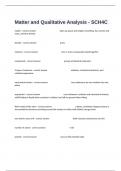
-
Matter and Qualitative Analysis - SCH4C Certifications Exam Practice Questions And 100% Verified Answers.
- Exam (elaborations) • 7 pages • 2024
-
Available in package deal
-
- $13.49
- + learn more
matter - correct answer takes up space and weighs something, has volume and mass, and thus density density - correct answer g/mL mixtures - correct answer two or more compounds mixed together compounds - correct answer groups of identical molecules 3 types of mixtures - correct answer ...
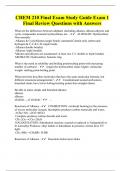
-
CHEM 210 Final Exam Study Guide Exam 1 Final Review Questions with Answers
- Exam (elaborations) • 18 pages • 2023
-
Available in package deal
-
- $10.99
- + learn more
What are the differences between aliphatic (including alkanes, alkenes,alkynes and cyclic compounds) aromatic hydrocarbons are. - ALIPHATIC Hydrocarbon: Non-aromatic -Alkanes & CycloAlkanes:single bonds; saturated:Contain only carbon and hydrogen & C-C & C-H single bonds -Alkenes:double bond(s) -Alkynes: triple bond(s) *alkenes and alkynes are unsaturated: at least one C-C double or triple bond(s) AROMATIC Hydrocarbon: benzene ring What is the trend in solubility and boiling point/mel...
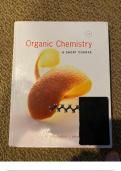
-
Organic Chemistry A Short Course 13Th Ed By Hart - Test Bank
- Exam (elaborations) • 260 pages • 2023
-
- $28.11
- + learn more
Chapter 3 -- Alkenes and Alkynes MULTIPLE CHOICE 1. Which of the following dienes can be classified as conjugated? A) CH3CH=C=CH2 B) CH3CH=CHCH=CH2 C) CH2=CHCH2CH=CH2 D) CH3CH=CHCH2CH2CH=CH2 E) CH2=C=CH2 ANS: B TOP: Alkenes and Alkynes: Nomenclature and Structure 2. Which of the following molecular formulas could not represent an alkene? A) C5H10 B) C7H14 C) C10H20 D) C27H56 E) C31H62 ANS: D TOP: Alkenes and Alkynes: Nomenclature and Structure 3. What...
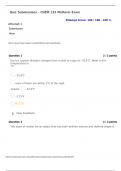
-
CHEM133 Week 7 Midterm Exam (Spring) Questions and Answers APU
- Exam (elaborations) • 26 pages • 2023
- Available in package deal
-
- $32.99
- + learn more
1. Question: Dry ice (carbon dioxide) changes from a solid to a gas at –78.5°C. What is this temperature in °F? 2. Question: The state of matter for an object that has both definite volume and definite shape is 3. Question: In 1828, the diameter of the U.S. dime was changed to approximately 18 mm. What is this diameter when expressed in nanometers? 4. Question: A piece of antimony with a mass of 17.41 g is submerged in 46.3 cm3 of water in a graduated cylinder. The water level increases t...
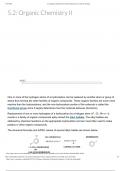
-
5.2: Organic Chemistry II
- Summary • 4 pages • 2024
-
- $17.99
- + learn more
5.2: Organic Chemistry II One or more of the hydrogen atoms of a hydrocarbon can be replaced by another atom or group of atoms thus forming the other families of organic compounds. These organic families are much more reactive than the hydrocarbons, and the non-hydrocarbon portion of the molecule is called the functional group since it largely determines how the molecule behaves (functions). Replacement of one or more hydrogens of a hydrocarbon by a halogen atom (-F, -Cl, -Br or –I) resu...
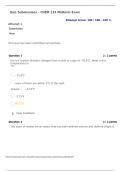
-
CHEM133 Week 7 Midterm Exam (All Correct)
- Exam (elaborations) • 26 pages • 2023
-
Available in package deal
-
- $35.48
- + learn more
1. Question: Dry ice (carbon dioxide) changes from a solid to a gas at –78.5°C. What is this temperature in °F? 2. Question: The state of matter for an object that has both definite volume and definite shape is 3. Question: In 1828, the diameter of the U.S. dime was changed to approximately 18 mm. What is this diameter when expressed in nanometers? 4. Question: A piece of antimony with a mass of 17.41 g is submerged in 46.3 cm3 of water in a graduated cylinder. The water level increases t...

Did you know that on average a seller on Stuvia earns $82 per month selling study resources? Hmm, hint, hint. Discover all about earning on Stuvia


